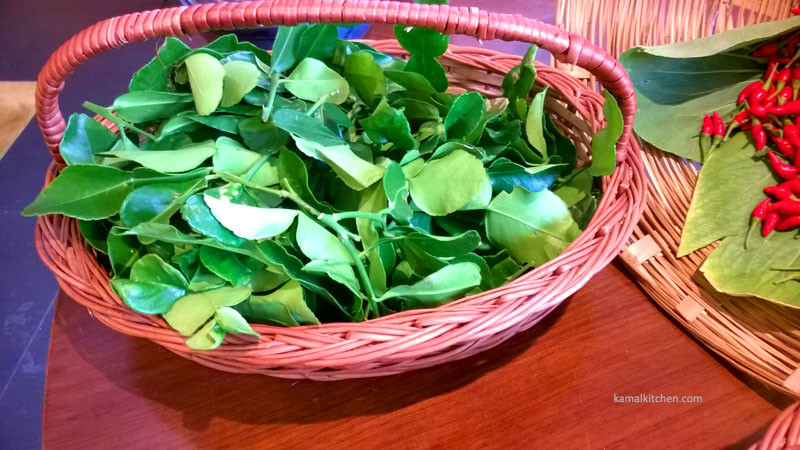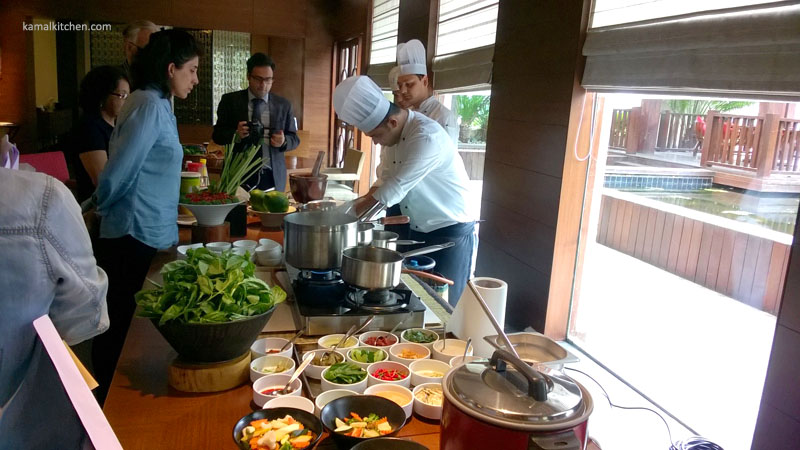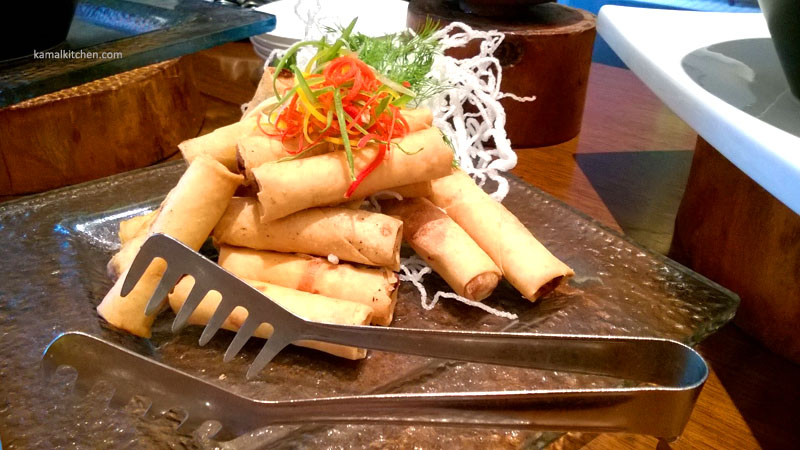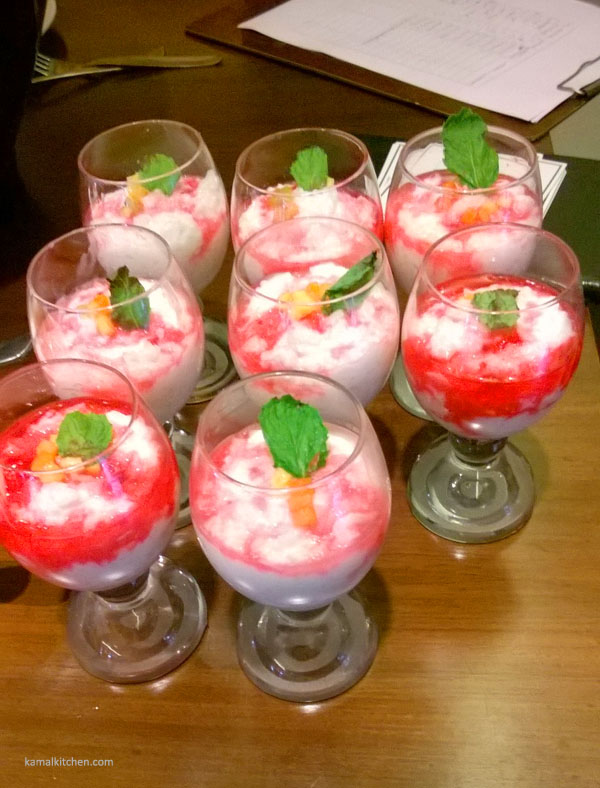Before I start writing about this, I want to take a moment to recognize a milestone. I just published 250 blog posts on kamalkitchen.com. This is the 251st. For some reason, I never celebrate(d) any blogging milestones, but this blog has come a long way since it started in 2008. There were times when I hardly blogged once a month, when I was focusing on writing more at my company blog. Happens!
I am just glad I have stuck it out thus far and hope to continue with your blessings and best wishes. Enough said!
The Thai Master Class at Baan Tao saw a group of enthusiastic foodies gathered together, listening and watching intently as Chef Sunil Joshi explained the nuances of authentic Thai food and cooking.
As regular readers know, I attended the Mango Master Class at the Hyatt Pune a few weeks ago. Considering that Baan Tao is the top Thai restaurant in Pune, I certainly did not want to miss their Thai Master Class.
I have been cooking my version of Thai food at home for years, but I never pass up on a learning opportunity, especially when it is from someone who is more trained and experienced than me.

Galangal root essential in Thai cooking
At a time when everyone is ready to be a self professed foodie, there are very few people who actually want to don an apron and get their hands dirty in the kitchen. But few as we may be in number, there is definitely a big bunch of passionate cooks who want to hone their kitchen skills and learn a whole new cuisine, or even newbies who are ready to experiment.
What is a master class, you ask? Obviously, the term has come from the ever popular Master Chef series on TV. If you ask me, it means learning at the hands of a master so you may master some of his skills yourself :). And this is exactly what we achieved at the Thai Food Masterclass.
Chef Sunil started by telling us about the must have ingredients for Thai cooking. This included galangal, which is a ginger like root but has a very different flavor. The chef suggested using galangal or totally skipping it. There is no substitution for it, he said, and ginger should not be used instead of it.

Pea Aubergines and Thai Bird’s Eye Chili
The next ingredient is of course lemon grass. We generally get the lemon grass leaves easily here in Pune, but the white stem is generally cut off by the vendors before they sell the leaves.
Basil, especially Thai basil is used abundantly in Thai food. But we can use the basil we get here, which is more of an Italian basil variety.
Thai bird’s eye chillies are tiny and very, very hot (ask me). Once again, we can or have to use locally available fresh red chili.

Kafir Lime Leaves
The kafir lime leaves are another ingredient which impart a peculiar flavor and are really hard to get.
The surprise here was pea aubergine, commonly known as karvanda or karonda. This tart berry like fruit/ vegetable was added in a small quantity to the soups and curries.
Coconut milk is another mainstay of Thai cooking, especially in the Tom Kha soup or in Thai curries.
I liked that the chef taught us how to make a Thai stock. Thai stock forms a strong flavor base for the soups, and it is the lemon grass, lime leaves, galangal and basil which give it unique flavor.

Chef Sunil demonstrating how to make raw papaya salad
We learned how to make some of the most popular Thai food dishes. The Som Tam raw papaya salad was followed by the Tom Kha soup and Tom Yum Goong soup. These were followed by the Thai Green curry and Thai Red curry. After all this spicy food, a dessert was called for. The chef demonstrated a super simple dessert – a rice pudding with a coconut milk base. He used cooked rice for the pudding, and I feel it is a great way to use up leftover rice, or feed that sweet tooth in a hurry.
The aromatic flavors of the Thai food hung in the air, and we found our bellies rumbling at the thought of all this exotic goodness. Eagerly, we filled our soup bowls and plates to try out all the scrumptious food.
I was really glad that there was a mix of both vegetarian and non-vegetarian dishes cooked and available for tasting. They showed immense foresight in making both camps happy.

Hands on step by step demonstration as Thai stock bubbles on the stove
What about shrimp paste and fish sauce? Well, honestly, it is tough to get umami flavors without using these. If you are allergic to these, then obviously they need to be left out. But people are vegetarian for various reasons.
If you are the type of vegetarian that is not allergic to fish, and is open to tasting non-vegetarian ingredients in a disguised form, maybe a splash of fish sauce will elevate the flavors of your food. This is just my opinion, of course.
It is hard enough to get Thai cooking ingredients readily in India. So OK, don’t tell me about Dorabjee’s or Godrej. We don’t go to these places every day. And smaller towns certainly don’t have them. That is why it is commendable that the Chef started with the basics and provided substitutions, like for the roasted chili paste. And he also clearly stated where substitutions would not work like in the case of galangal.

Spring Rolls to nosh on
Vegan fish sauce, made from mushrooms or nori is supposed to compensate for the real thing. But it is next to impossible to easily source it.
With more and more people wanting to cook exotic food in their own kitchen, the whole master class concept is picking up. Hyatt Pune has many more exciting classes coming up in the next few months on baking, bread making etc. The best way to stay in the loop about these is to follow their Facebook page where such announcements are made.

Jasmine rice and coconut milk based dessert – Drizzled with rose syrup
You can also follow my Facebook Page where I regularly share news about events like Food festivals, contests, master classes etc. from different Pune restaurants :).
What better way to spend a rainy Saturday? Thank you to the folks at Hyatt Pune for making this such a valuable experience.
Congratulations! On 250 blogs,
Aww..how much am I aching to attend a masterclass. It has been long. Hope they do something in Mumbai soon.
Pragati, do check out my post on Thai Food Fest at JW Sahar
Nice one……
I was wondering how many posts have you written so far (with the shares on twitter)…well, no need for me to guess! Congratulations, on both the count and the masterclass!